by California Casualty | Firefighters |
With the holidays fast approaching, here are good health reads and tips for firefighters and friends.
Should Firefighters Do Crossfit?
by Dr. Karlie Moore. This article was originally published on www.fitfordutyconsulting.com
Crossfit has become very popular, and many of the firefighters have asked me what I think about it in terms of safety and effectiveness. So here’s my opinion: Crossfit is a great full-body workout and one that I think could be beneficial for firefighters since it is high intensity, it improves all the components of fitness, and it burns a lot of calories. However, I encourage people to use caution when doing Crossfit, or any extremely challenging exercise for that matter, since the potential for injury is obviously increased. Research illustrates that fatigue significantly compromises good technique, so that is concerning when the goal is to perform as many repetitions as possible in a given amount of time.
Crossfit encourages a very large range of motion for most joints in the body. This can be really helpful for some who need to improve their flexibility, but detrimental for others who don’t have (and never will have) the ligamentous support to keep their joints in a safe position when performing these moves. So, when performing this type of exercise, it becomes extremely important to listen to your body and back off if you feel any overuse injuries coming on.
The training to become a Crossfit instructor is not, in my opinion, too rigorous. So although I often hear that Crossfit instructors enforce that their clients start out slow and make sure they are doing things “right,” I wonder to myself “well do they know what right really is?” So make sure your Crossfit instructor has a strong background in strength and conditioning and a real appreciation for injury avoidance. A good site to follow if you want to be sure you’re getting correct information is https://www.mobilitywod.com/. Kelly Starrett, DPT, is a fellow doctor and a proponent of Crossfit.
Ultimately, I’m ecstatic that so many people have found a love of exercise through Crossfit. But I don’t think it’s right for everyone. Ultimately, there is no ONE right way to exercise for everyone; it depends on your body type/build and your strong and weak areas.
Find lots more FREE health tips for firefighters at www.fitfordutyconsulting.com
Author bio:
Dr. Karlie Moore holds a PhD in Exercise Science and Nutrition from Oregon State University. She has dedicated her research and work to helping firefighters improve their health so they can live long, happy lives. Dr. Moore conducts comprehensive fitness assessments for several fire departments in Oregon and speaks on all topics related to firefighter health. She is also a part-time professor at Oregon State University. More information about Dr. Moore’s services, along with free health tips for firefighters, can be found at www.fitfordutyconsulting.com
by California Casualty | Firefighters |
The job of a first responder is very challenging. In an earlier article I stressed the importance of mental health. I am now turning my focus to the physical aspects we face at work. It is imperative that we stay in the best shape possible. We owe it to the community we serve and our fellow brothers and sisters.
It’s not as easy as one would think. Many firefighters have turned to CrossFit, which is good for some but not for everyone. One of the best things your department can do is provide time and equipment to stay in top physical shape. We need to be cardiovascular fit, strong, flexible and keep our minds in shape. Shift work can make it difficult to train so we must train at work.
I have never been one who loves the gym or working-out inside. With our jobs we need to find balance and learn to cross train. With this said, most of us need to hit the gym at work. Some of us work 24s and others work 48s; my dept is on a 48 hour shift. Working shifts means you have to utilize whatever workout your dept. offers. We have a gym we can go to and exercise equipment in our station. I choose to utilize our station equipment.
We have stationary bikes, elliptical machines, free weights and a nautilus weight machine. Personally I like to spin. Cardiovascular training is just as important as weight training. Some departments use cross fit, which is good but be careful jumping into this if you are out of shape. Cross Fit is something you should and can work up to. Some departments are using firefighter specific workouts. Whatever you do it should include cardio.
Cardiovascular training, in my opinion, is necessary. When you are working a structure fire you are only as strong as the weakest link on your team. We go in as a team and come out as a team. If one of the members of your team is not up to par with the others, you can only stay interior as long as the weakest link. It is detrimental to the unit if one of your members burns through a bottle of air at twice the rate of the others. You may be doing an interior attack or a search. If one member is low on air we all must exit the building. This is non-productive. It is one of the reasons cardiovascular training is so important. Of course the main reason is our heart is a muscle. If we don’t exercise it we will be at risk of a cardiac event. This could lead to what is called an incident within an incident. This incident can cause your brothers and sisters a great amount of stress, PTSD, and may even lead to a suicide in your dept.
While I push the importance of cardio, weight training is also essential. You don’t have to lift heavy weights, in fact it’s better to lift light with high reps. Going with light weights will increase your strength while elongating your muscles, which reduces the chance of injury on the job.
Core body strength and strengthening your back is imperative. With this said, you need to work your stomach and back. Next to heart attacks, back injuries are probably the number one reason firefighters and EMS personnel miss work. Cardiovascular training, weight training and core body strength can be achieved by making sure you train while on shift. If you don’t have equipment, find a workout program specific to the job. I encourage all chief officers to allow at least 1 hour of part of a day; 2 hours is optimal. You should always start and end your workout with stretching or yoga. On your days off, make your workouts fun.
You can run, bike, ski, hike, swim, paddle, climb, row or find something else to do outside. Personally I like to cross train with climbing, biking, skiing, stand up paddling and swimming. Find something that is fun in your area. It can be something different; in fact a great option is organized sports. At the very least, walk swiftly for 3 miles.
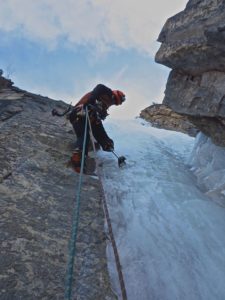 Personally, climbing is my favorite past time. I find climbing is the one sport that lets my mind rest. When I climb I can only think about the climb. This frees your mind by allowing it to focus only on the task of making it to the top. Climbing also increases strength and flexibility. I am fortunate to have the mountains and dessert as my playground. The last thing I would like to discuss is TRE therapy or meditation.
Personally, climbing is my favorite past time. I find climbing is the one sport that lets my mind rest. When I climb I can only think about the climb. This frees your mind by allowing it to focus only on the task of making it to the top. Climbing also increases strength and flexibility. I am fortunate to have the mountains and dessert as my playground. The last thing I would like to discuss is TRE therapy or meditation.
I find it difficult to meditate as my mind wanders. TRE therapy is taught in 35 countries. It stands for tension and trauma release therapy. I recently learned this and it is very easy and can be done at work or home. TRE includes a series of 7 steps. These steps end with the TRE tremor position. TRE uses the body’s innate process of controlled shaking to reduce stress and trauma, including PTSD. This revolutionary approach is doing wonders for me.
In conclusion, we are public servants. With this comes a responsibility to keep in shape. As we get older the stress of the job and life’s stressors can lead us to cope in unhealthy ways. I encourage you all to make a commitment to your community and fellow brothers and sisters. Of course we can’t control our genetic makeup, but we can make a commitment to physical and mental health. Let’s turn the tide towards less injury, death, PTSD and suicide of first responders. With a commitment we can turn the tide.
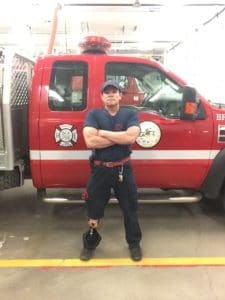 Jeff lost his right leg below the knee at the age of 50 as the result of a skiing injury. Instead of wallowing in pity, Jeff rebounded physically and mentally through physical therapy and exercise. He returned to work as firefighter/EMT a year later and is now back on the job fulltime. He strives to be the best firefighter/EMT he can be, and also to be an inspiration to others. Jeff welcomes your thoughts and comments at jeffbryan50@yahoo.com.
Jeff lost his right leg below the knee at the age of 50 as the result of a skiing injury. Instead of wallowing in pity, Jeff rebounded physically and mentally through physical therapy and exercise. He returned to work as firefighter/EMT a year later and is now back on the job fulltime. He strives to be the best firefighter/EMT he can be, and also to be an inspiration to others. Jeff welcomes your thoughts and comments at jeffbryan50@yahoo.com.
by California Casualty | Firefighters |
Jeff Bryan is a firefighter who doesn’t let adversity keep him down. Jeff returned to full time work in March 2015, just slightly less than a year after his right leg was amputated below the knee. Jeff severely injured that leg in a 1991 skiing accident in Colorado. He “limped by” in pain until doctors determined the leg had to be removed. Jeff, who is a firefighter and EMT Intermediate with the Ute Mountain Fire Department in southwest Colorado, refused to let the amputation keep him down. He was released from the hospital on his 50th birthday. He says there were two ways to go: give up and feel sorry for himself or push forward and beat it – he chose to move beyond and conquer it.
As soon as he was able, he started bicycling, ice climbing, paddle boarding, swimming and yoga. As far as anyone can determine, Jeff is the only firefighter in Colorado to return to full-time active duty after a leg amputation. Jeff does not want to be known as the firefighter who lost a leg, but the guy who works hard to stay in shape and be the best EMT/firefighter he can.
What’s his philosophy and how does he train? He spells it out here in his own words:
In 1991, I suffered a commuted fracture of my tibia while skiing in Breckenridge, CO. It was during this injury that I first trained to get my life back.
In 2011 I had an ankle replacement. I once again undertook the task of regaining my fitness; however, I never regained my top physical condition. For the next 3 years I worked in unbearable pain. I basically, worked, slept and trained in the gym. I developed high blood pressure. I was getting sick.
On March 20, 2013 I worked a 72. On the 23rd I clocked out and headed to Vail to meet my doctors. Four days later, I was told my best option was amputation. I spent the next three days lying in bed. During this time I made the decision that failure was not an option.
On April 22, 2014 I had a below the knee amputation. I went for an Ertl amputation since I qualified. The Ertl procedure is designed to build muscle and preserve bone that will support prosthetic devices for those who plan to be active. The surgery went well and I was released from the hospital 4/26, my 50th Birthday.
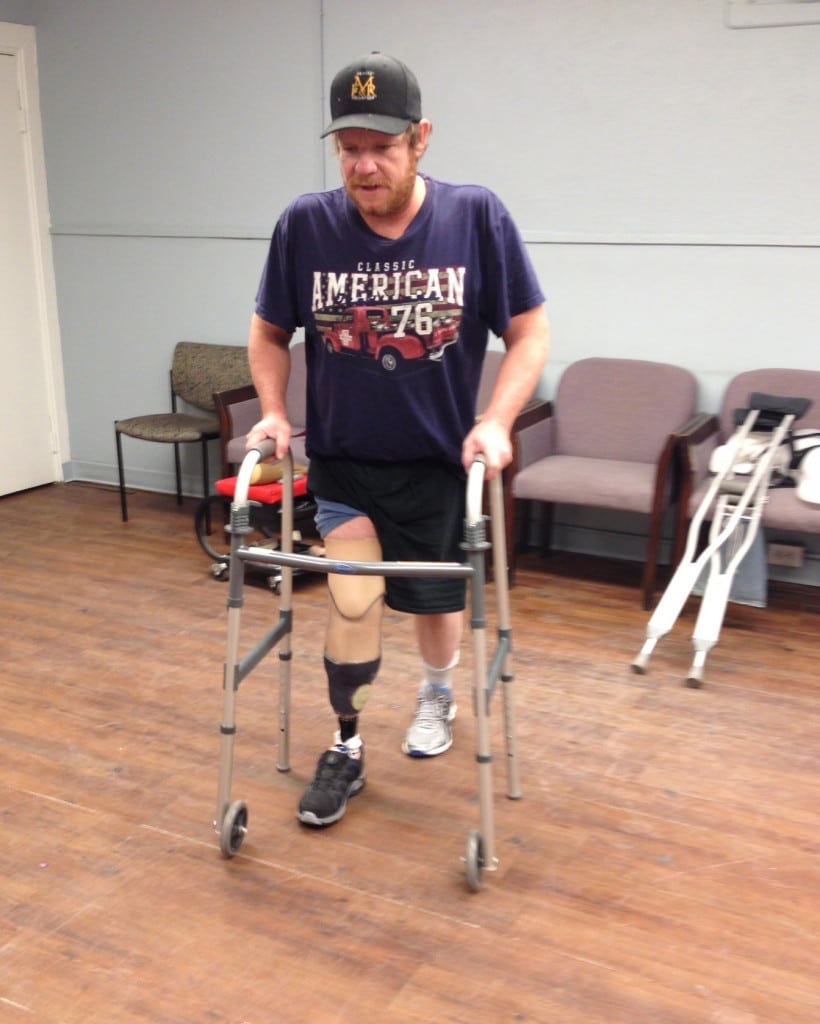
Now 30 pounds overweight, I had a huge undertaking. I needed to lose the 30 pounds and fulfill my goal of returning to active duty. 50 years old, overweight and now an amputee!

I started out just the way I did in 1991. At four weeks I started riding the bike with one leg. At six weeks I received my first prosthetic and was on my way to PT. I followed my instructions to a tee. I continued to bike and work on balance. At this time I also started yoga.
At my age I did not need to increase my calorie intake above 2000 calories a day. I eat a balanced diet, consisting of plenty of fruits and vegetables, chicken and grass fed beef, which I purchase by the half cow. Once a week I splurged and enjoy a bowl of Ice cream. I drink water, 10-12 glasses a day. I never drink soda.
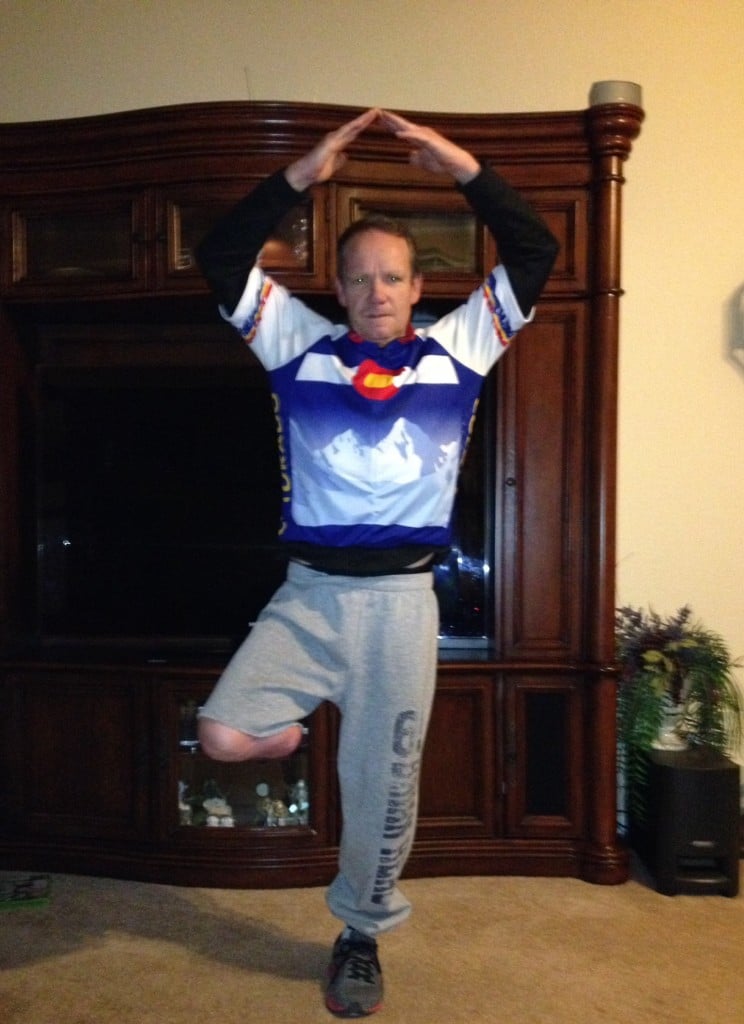
Within a week of getting my first prosthetic I went out on my stand up paddle board. I spent a lot of time swimming, paddling, spinning and lifting. I am a firm believer in high reps, low weight.
We all hear the term crossfit. I do not do a crossfit program. I am a firm believer in cross training, consisting of cardio, core, flexibility and strength training. As I progressed, I started to add new activities. In July, I started rock climbing. In August, I started biking outside.
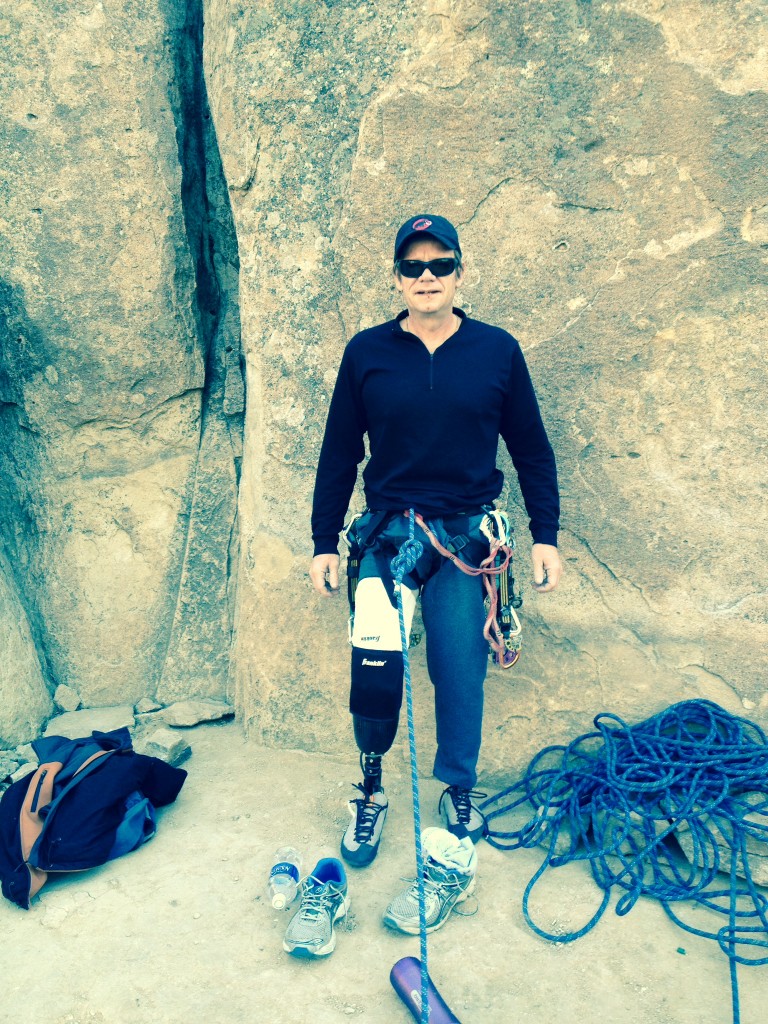
At 50 years old, avoiding injury is key. Yoga or a good stretching routine should be done daily. Cardio should be done a minimum of three days a week. I prefer four or five, but three will work. I do weight training four days a week. All my weight lifting is done either after cardio or after I ride my bike to the gym. I never lift heavy. I keep my reps at a minimum of 12. I usually do sets of 16-24. I lift for endurance, strength and elongated muscle. Heavy lifting will not only decrease flexibility, it will Increase your risk of injury.
The idea is to move fluidly between cardio and strength while resting as little as possible. As I progressed I added more activities. I started to climb ice, backcountry ski, bike hard and stick to my routine. The idea is to mix it up and have fun.
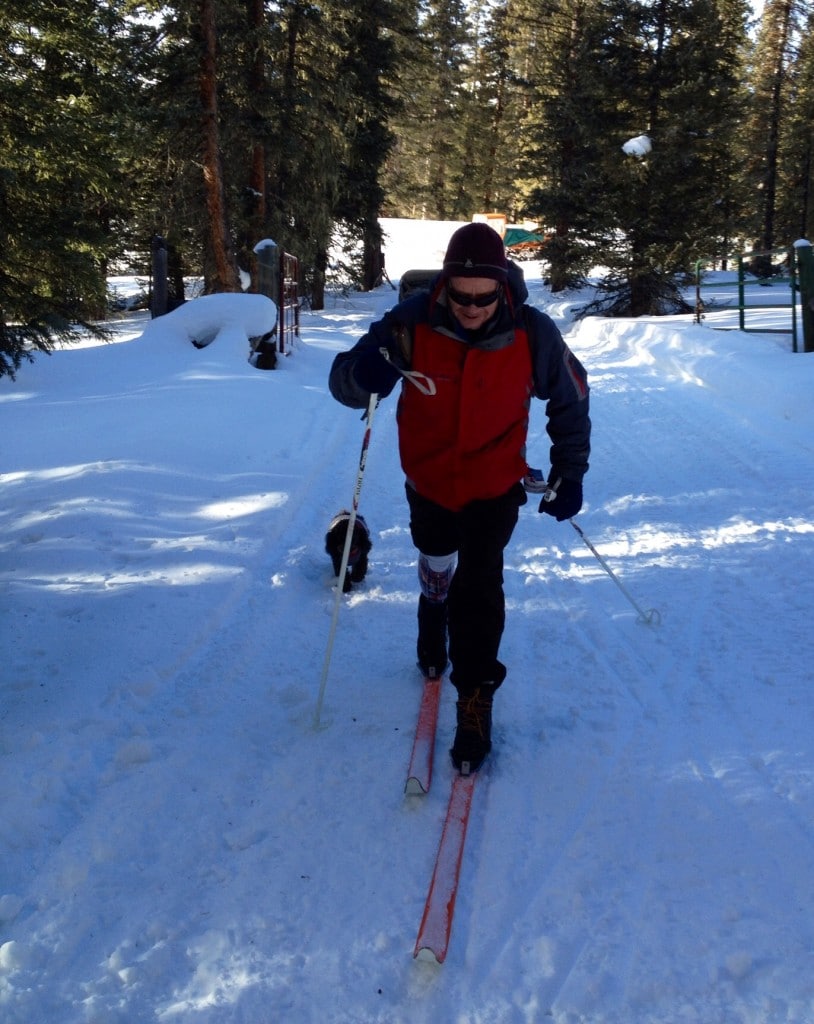
In January I started ice climbing again. I was climbing strong and climbed as much as I could. I started riding single track on my mountain bike in March. I mix it up as much as possible. Your workout should not be a chore, it should be fun. If you’re not having fun, try something different. Start slow and increase your intensity. I add weight very gradually. I make sure I can do a set of 24 before I up my weight. My bike rides started out at five miles. I am now averaging about 25 per ride on my road bike and 10 miles a day on single track. Just remember Cardio, Core, Flexibility and Strength.


As the seasons change, I take advantage of the weather. I cross country ski, climb, bike or paddle. I still do a minimum of four days lifting; once again, never with heavy weight. I am a true believer that flexibility, elongated muscle, core strength and endurance is the key, especially for firefighters and first responders (more on that in coming articles).
And, all this is working. At nine months I was cleared for full duty by my doctor. At 11 months, I had cleared my final physical. In March, I returned to full duty as a line firefighter and my first shift was 3/7/15.
*Note- Jeff completed the first 30 days of his 90 day probation on April 7 without any issues. He is committed to being the best first responder he can, serving the Ute Mountain Ute Tribe of Southwest Colorado.

 Personally, climbing is my favorite past time. I find climbing is the one sport that lets my mind rest. When I climb I can only think about the climb. This frees your mind by allowing it to focus only on the task of making it to the top. Climbing also increases strength and flexibility. I am fortunate to have the mountains and dessert as my playground. The last thing I would like to discuss is TRE therapy or meditation.
Personally, climbing is my favorite past time. I find climbing is the one sport that lets my mind rest. When I climb I can only think about the climb. This frees your mind by allowing it to focus only on the task of making it to the top. Climbing also increases strength and flexibility. I am fortunate to have the mountains and dessert as my playground. The last thing I would like to discuss is TRE therapy or meditation. Jeff lost his right leg below the knee at the age of 50 as the result of a skiing injury. Instead of wallowing in pity, Jeff rebounded physically and mentally through physical therapy and exercise. He returned to work as firefighter/EMT a year later and is now back on the job fulltime. He strives to be the best firefighter/EMT he can be, and also to be an inspiration to others. Jeff welcomes your thoughts and comments at
Jeff lost his right leg below the knee at the age of 50 as the result of a skiing injury. Instead of wallowing in pity, Jeff rebounded physically and mentally through physical therapy and exercise. He returned to work as firefighter/EMT a year later and is now back on the job fulltime. He strives to be the best firefighter/EMT he can be, and also to be an inspiration to others. Jeff welcomes your thoughts and comments at 





